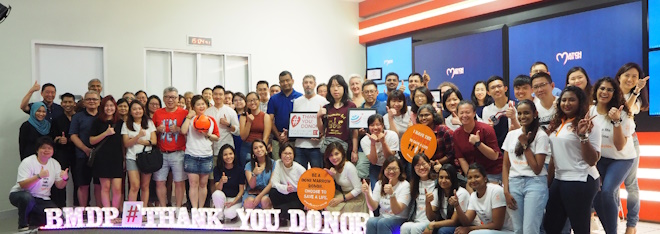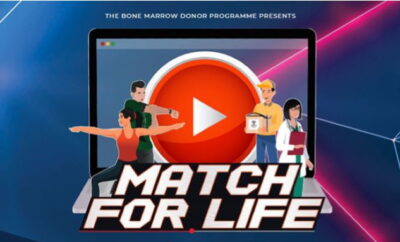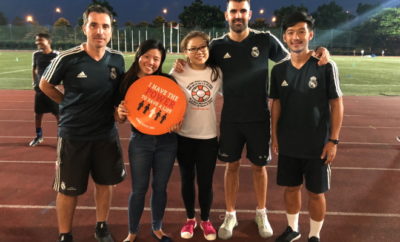
Insights + interviews
Equal representation in the Bone Marrow Donor Programme is crucial
Equal representation is crucial to give every individual a fair chance at finding a life-saving bone marrow match.
The Bone Marrow Donor Programme (BMDP) recognises that our donor pool must reflect the multicultural society we live in.
However, data suggests that Malays and Indians are not adequately represented in the bone marrow donor register.
Every year, numerous individuals face the daunting prospect of finding a matching donor to combat life-threatening blood-related diseases.
Through an ongoing series of engagements, such as awareness talks, recruitment drives, roadshows, and community outreach, BMDP is determined to rally the support needed to increase the number of donors from the minority community.

We discuss this challenge with Mr Charles Loh, CEO of Bone Marrow Donor Programme and cover topics such as changing perceptions, the need for more minority representation in the donor register and several misconceptions about bone marrow donation.
the Active Age (AA): What and how has BMDP and its mission evolved over the years?
Mr. Charles Loh (CL): The Bone Marrow Donor Programme was established in 1993 by Mr Gerald Loong and his wife, after they lost their young son to Leukaemia. It holds the only marrow donor registry in Singapore and provides the donor search services to all patients requiring a stem cell transplant. This service is provided free of charge.
As BMDP manages Singapore’s only register of volunteer marrow donors who are willing to donate their bone marrow, our mission involves educating the public on blood diseases and recruiting as many marrow donors as possible, given the low probability of finding a perfect match. Our mission is therefore to provide hope for patients with Leukaemia, Lymphoma and other blood-related diseases by finding them a Matched Unrelated Donor who is their last hope of survival.
BMDP is reaching its 30th-year mark this 19th July, and our mission has not changed since. In fact, in the past few years, BMDP has launched several new initiatives as we seek to do more for patients with blood diseases. We have implemented our patient subsidy schemes to support those in financial need. We have expanded our services to support those patients who are getting their stem cells from a related source. Operationally, we strived to attain a higher level of professionalism and in 2021, we obtained our accreditation from the World Marrow Donor Association, the first Southeast Asian country to do so.
Moving forward, we hope to be able to do more for patients, especially during their post-transplant recovery journey. As we ready ourselves to remain relevant with the advancement of medical science, cellular therapy is a space that it will be involved in. Cellular therapy is an alternative form of treatment for patients with blood diseases. Particularly, it will target patients who are at a high risk of not responding to conventional chemotherapy and/or likely to relapse.
BMDP is embarking on a partnership with NUS Yong Loo Lin School of Medicine for this project – funding NUH with 3.6 million for clinical trials and treatment of Cellular Therapy. Getting involved in this project is not just an extension of BMDP’s services to its patients as part its mission to save lives; it is required given its important impact on the donor registry. Hence, it is timely BMDP readies itself for the day when unrelated donor cells will be used in this therapy.
AA: What are some of the challenges in explaining the mission to potential donors?
Cl: We have two big challenges — recruiting marrow donors for Singapore’s one and only marrow donor registry and marrow donor dropout. As it is entirely voluntary, we need every support available to educate the public about blood diseases and encourage sign up to the registry. In particular, we need the support of the media and high-profile individuals.
There are stigmas surrounding bone marrow donation. The most prevalent myth is that bone marrow donation causes long-term infertility. This is untrue as there is no evidence that bone marrow donation affects fertility at all.
Most people were also misinformed and had the impression that bone marrow is usually taken from the spine. Bone marrow donation is a relatively safe process. There are two donation methods and neither requires complex surgery. 90 percent of our donors opt for the Peripheral Blood Stem Cell (PBSC) collection, which involves the collection of blood stem cells from the blood stream. 10 percent of our donors opt for the Bone Marrow collection, where blood stem cells are collected from the pelvic bone while the donor is under general anaesthesia.
People also think that they are giving a part of their bone away. In reality, bone marrow is the soft tissue inside the bones that produces blood cells and our body will regenerate the donated stem cells within 4-6 weeks.
Such misconceptions are barriers to registration.
In fact, there are also cases of registered donors who face objections from family and loved ones from proceeding with the bone marrow donation. At BMDP, family objections constitute as one of the top few reasons for donor drop-outs. It is a challenge that the charity has been trying to mitigate for it only means dashed hopes for patients in surviving. Currently, the dropout rate is 1 in 3 and we hope to reduce this significantly.
AA: Why do we need equal representation in the bone marrow donor register and by what time frame? What happens if we do not achieve this goal?
CL: The chances of local patients in finding a local donor are unfortunately less than half for each ethnic group – Chinese: 40 percent; Malays: 20 percent; and Indians: 2 percent.
Malays and Indians in particular are severely under-represented in the BMDP register. Malays make up 8 percent while Indians make up 9 percent of the register, making it more challenging for patients with diverse ethnic backgrounds to find a match.
In addition, a study was conducted to determine the optimum size and ethnic composition of the BMDP donor pool and improve the probability of finding a local donor for a local patient. From the study, we concluded that the optimum size for BMDP registry is about 350,000. Assuming we recruit about 15,000 donors per year, it will take us 16 years to reach our optimum size. But, this is a projection on the high side. Based on the big decline in recruitment numbers during the COVID period when we were only able to recruit about 2,000 donors per year, as well as the reduced effectiveness of our recruitment channels post-COVID, it is likely to take us a longer period of time.
This is therefore an urgent call to all eligible members of the public, especially Malays and Indians, to understand this urgency and put yourself in the register.

AA: How is BMDP seeking to change perceptions around the mission and these misconceptions?
CL: Outreach efforts have been ongoing for the longest period of time through awareness talks, recruitment drives and roadshows in schools, shopping malls, corporates and organisations as well as the uniformed groups. In recent years, we have also stepped up our public education and recruitment efforts online.
Despite the lifting of the restrictions on face-to-face activities brought about by COVID-19, the number of registered marrow donors in Singapore has continued to drop significantly in the past two years. We have to develop new ways to engage the public and we hope to see:
- More individuals to step forward to be a marrow donor or BMDP’s ambassador and share our mission to their network
- More companies to open their doors to BMDP’s staff to make presentations
- More commercial spaces to provide spaces for our educational roadshows
- A greater support from the media to help in this task of public education
- We also need more people to champion our cause, especially those who have a strong network
AA: Can you summarise the process for a potential donor from start to end, and how has this process improved over the years?
- Registration
Complete a registration form, along with performing a cheek swab.

- Verification Typing
If you are found to be a match, you will be called up for Verification Typing to confirm that you are the best match for the patient.
- Donor Workup
You will be requested to go through a thorough medical check-up to ascertain that you are physically fit for the donation.
- Donation
There are two donation methods, of which both are safe and straight-forward. The Peripheral Blood Stem Cell (PBSC) Collection involves the collection of blood stem cells from the blood stream. The Bone Marrow Collection is another method where liquid marrow is collected from the back of the pelvic bone while the donor is under general anaesthesia.
- Follow-up
After the donation, you will go through routine medical follow-ups to ensure you are in the pink of health.

I’d like to think I’m a slightly better version of my former self. No one wants a critical illness to learn life lessons. Strangely enough, a lot of good has come out of it. I stress far less, I don’t worry about things that are out of my control. I take more time to do things that I enjoy and I value the personal relationships that I have far more than ever before.
Ian Lim, Stem Cell Recipient

As I told my donor, the second lease of life that she has given to me, has allowed me to continue to do good and add value to my loved ones and friends. Her single decision to say “Yes!” continues to reverberate in many, many lives around me. Something that I truly am grateful for.
Sophia Tan, Stem Cell Recipient
All pictures credit to BMDP








